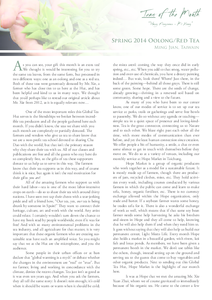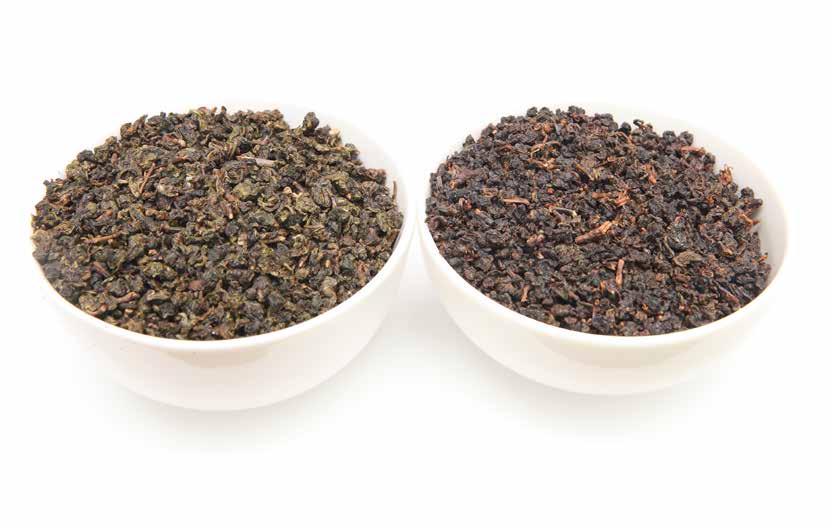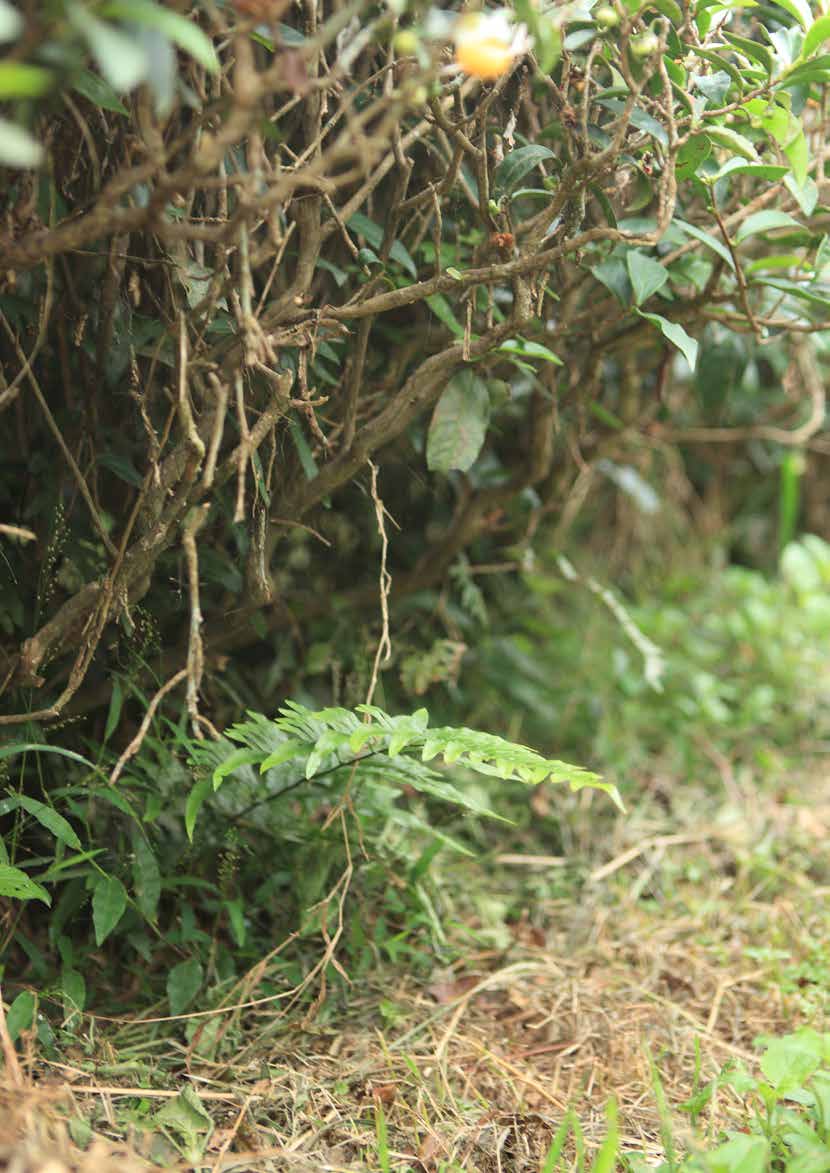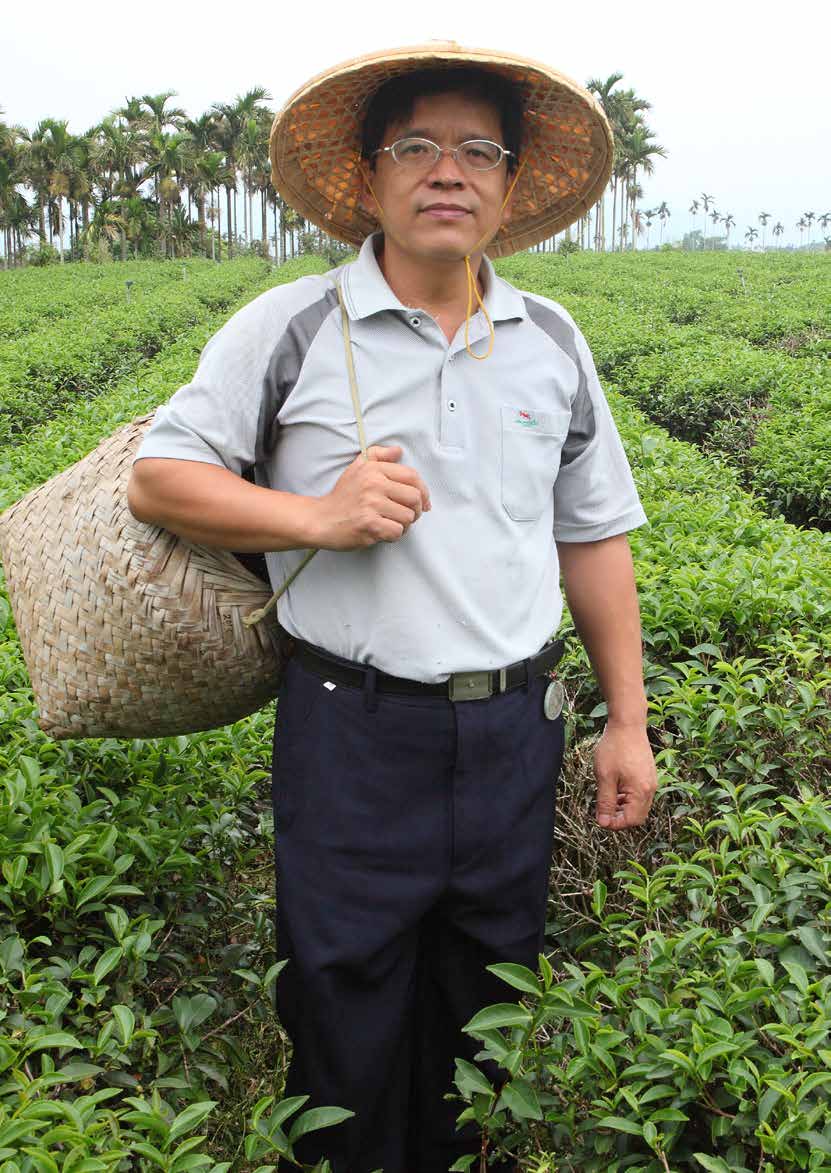
 |
|

As you can see, your gift this month is an extra tea! We thought it would be interesting for you to try the same tea leaves, from the same farm, but processed in two different ways: one as an oolong and one as a red tea. Both of these teas were generously donated by Mr. Xie, a farmer who has close ties to us here at the Hut, and has been helpful and kind to us in many ways. We thought that you'd perhaps like to reread our original article about Mr. Xie from 2012, as it is equally relevant now...
One of the most important roles this Global Tea Hut serves is the friendships we broker between incredible tea producers and all the people gathered here each month. If you didn't know, the teas we share with you each month are completely or partially donated. The farmers and vendors who give us tea to share know that we are a non-profit tea school devoted to sharing Cha Dao with the world, but that isn't the primary reason why they share their tea with us. All of our classes and publications are free and all the guests who stay here do so completely free, so the gifts of tea these supporters donate to us help us to serve in this way. The farmers know that their tea supports us in this way, and of course think it is nice, but again it isn't the real motivation for their gifts: you are!
All of the amazing farmers who support us with their hard labor - tea is one of the most labor-intensive crops on earth - do so to share their tea with around thirty nations. I have seen two tap their chests with a tear-jerking pride and tell a friend how, "Our tea, yes, our tea is being drunk by someone in Spain!" They want to connect their heritage, culture, art and work with the world. Any artist could relate. I certainly wouldn't turn down the chance to have my book read by people worldwide, even if it was for free! And with so many environmental problems in the tea industry, and all agriculture for that matter, it is very important that these organic farmers who are creating sustainable teas have such an amplified voice. So you might say that we at the Hut are the microphone, and you the audience.
Some people in their urban offices or at bars declare that "global warming is a myth" or debate whether the changes in the environment are "real" or "true". But no farmer, living and working in concordance with the climate, denies the recent changes. Tea just isn't as good as it was even ten years ago. And when you ask the farmers, they all tell the same story: It doesn't rain enough; it's cold when it should be warm or warm when it should be cold; the mists aren't coming the way they once did in early spring, etc., etc. When you add to that smog, water pollution and over-use of chemicals, you have a dreary painting indeed... But wait, look there! Where? Just there, in the back of the painting - behind all those grays. There is still some green. Some hope. There are the seeds of change, already growing - thriving in a renewed soil based on community, sharing and a view to the future.
As many of you who have been to our center know, one of our modes of service is to set up our tea service at parks, trails or gatherings and serve free bowls to passersby. We do so without any agenda or teaching - simple tea in a quiet space of presence and loving-kindness. Tea is the great connector, connecting us to Nature and to each other. We blaze right past each other all the time, with more modes of communication than ever before, and yet the least human connection since creation. We offer people a bit of humanity, a smile, a chat or even some silence to get in touch with themselves before they move on. We do so at a variety of venues, including our monthly service at Hope Market in Taichung.
Hope Market is a group of organic producers who work together as a model for a sustainable future. It is mostly made up of farmers, though there are producers of jam, recycled clothes, miso, etc. They hold activities every week, including courses conducted by various farmers in which the public can come and learn to make tofu, honey, organic fertilizer, etc. There is no currency exchange allowed within the Hope organization, only trade and barter. If a soybean farmer wants some honey, he trades tofu for it. There is also a wonderful exchange of work as well, which means that if that same soy bean farmer needs some help harvesting he asks his brothers and sisters in Hope and they all come to help, knowing that he will also help them if and when they need him to. It goes without saying that they will also help us build our permanent center, Light Meets Life. Every month Hope also holds a market in a beautiful garden, with rivers, koi fish and lotus ponds. As members, we have been given a permanent booth in the market. We don't use tables like the others, though, instead setting up on the ground and serving tea to the guests that come to buy vegetables and other organic products. Next to sending out this Global Tea Hut, Hope Market is the highlight of our month here.

It was at Hope that we met the amazing Mr. Xie Yuan Zhai, whom we of course gravitated to immediately because of his organic tea. He came to the center a few times and we started visiting his farm. It was so easy for a friendship to develop (organically of course). He is kind and joyous, with smiles that fill a room, not to mention incredibly knowledgeable about tea. He's made every kind of tea you could imagine at some point, and has decades of experience.
Aside from providing this month's teas, which you are sure to love, Mr. Xie is a very important part of the scenery at our center, and will be very important for many of you as well, because so many of our visitors come here with a curiosity about how tea is processed. It is very important to experience with your own hands just how difficult it is to make tea, so that in your own soreness you will develop a tremendous respect for the Leaf. This respect isn't just in the billions of years of evolution, or in the Nature we always wax poetic about - the wind and rain, sun and moonshine, minerals, mountain and water that flow from roots to crown - it is also in the blood, sweat and tears of generation after generation of farmers. And there is a deep reverence in seeing just how much mastery, skill and, dare we say, art in the crafting of the Leaf. And so, with great joy we take as many of our guests as possible to a few different farms to try their hands at tea processing. It is amazing to make your own tea, and take it home with you. If you didn't have enough reasons to come stay with us, here's another: Mr. Xie has formally invited each and every one of you to come to his farm and make tea, eat a nice lunch and take the tea you picked and crafted home with you!
Mr. Xie is a third generation farmer in Ming Jian, Nantou, Central Taiwan. Ming Jian is lower altitude, in the foothills of the central mountain range. In the last few decades, such lower altitude tea has been adumbrated by the popularity of the teas grown higher up. Though areas like Hsinchu and Miaoli counties, where Eastern Beauty is grown, have struggled since high mountain oolongs have come to dominate the market, Ming Jian has prospered by providing lower priced teas for export, or largescale production for the bottled tea market (often called "Ready to Drink", or "RTD"). Mr. Xie's family has grown small-scale productions of oolong tea through three lifetimes, since before the higher teas even existed.
When we discuss organic farming and the need to make changes in tea farming - as well as other kinds of agriculture - it's important to remember that the farmers are always the first victims. It is they who handle the agro-chemicals in large amounts, and most directly. Furthermore, it is only by humanizing and befriending them that we can bring about change. We must include rather than exclude - educate rather than ostracize.
Like so many other farmers, Mr. Xie started to get the nagging (coughing, wheezing) feeling that these chemicals were harmful to his family, his community and his land. When his wife almost miscarried their second child in 1997, he had had enough. Despite opposition from friends and family, Mr. Xie made a commitment to become an organic tea farmer, no matter the cost. He first attended some organic farming classes held by the MOA organization.
MOA stands for "Mokichi Okada Cultural Services Association International." It was created by Mokichi Okada (1882-1955), who started three great projects in his lifetime: a "Mokichi Style Detoxification Treatment" for land, "Natural Agriculture, Drinks and Food" and "Fine Arts and Culture". These three projects created affiliated groups of people with common goals to help each other. His overall aim was "to allow humanity to expand and flourish, helping create healthier people, families, regions, countries and culture". His Japanese NPO natural agriculture culture movement created the Da Ren farm in 1982, and then in 1991 developed standards for healthy, organic agriculture. They began to set up branches and create a social system for theory and practical cooperation amongst farmers in Japan.
In April of 1990, a group of people who cared about Nature and were concerned about environmental pollution wanted to change the situation in Taiwan. They joined the Japanese MOA International Association and created a sister organization to educate farmers and legally certify organic foods and drinks. This Taiwanese foundation was formed to explore and seek health and happiness for mankind and to guarantee environmentally sustainable MOA natural agriculture, expecting this ideology and the sustainable agriculture techniques behind it to spread all over the world.
MOA certification is rather rigorous and they do a great job of ensuring sustainable, organic agriculture without much of the bureaucracy or financial interests that trouble a lot of for-profit organic certification worldwide. Watching for the MOA certification on teas is a good way to enter the world of organic Taiwanese teas.
From 1997 to 2000, Mr. Xie and his family struggled to maintain their principles. His tea was sub-par and he lost almost all his customers. His father, who had been worried when he suggested upsetting the status quo with the shift to organic production, was very critical of his decisions. Organic farming is difficult, and it requires a radical change in farming and processing methodology - changes that would take time to learn. Rather than give up, as many would have done, Mr. Xie got a part time job as a painter and carpenter, working day and night to keep his family afloat. Finally, in the early 2000's, his acumen for organic farming improved to the point that he was able to take his teas to market again. Since then he has gone on to win awards, been featured on TV and has even heard his father, now a sprightly eighty years old, bragging to others about how his tea is organic and good for the environment.
Mr. Xie's work hasn't stopped with his own farm. He knew that he would have to keep improving his skills, creating new and better teas, and help show his neighbors the value of organic farming, especially since their land and his are close enough to influence each other. He formed a co-op with other farmers and began teaching locals to shift to organic methods, offering them equal shares in their combined enterprise. As more people have joined this local group, the incentive to do so has also increased. To date, more than twenty-five farmers in the Ming Jian region are organic, including Mr. Xie's immediate neighbors.
Mr. Xie's kind heart shows in his teas. He cares deeply about tea and the Earth. He produces green tea, large and small leaf red tea, as well as several kinds of oolong; and all with great skill. He's also generous with his tea. To us, he is an inspiration and a kind of hero - the kind not talked about enough these days. It's easy to follow the crowd, maintain the status quo; or to say that "I am just one person. What can I do?" It is difficult to face criticism from family and friends and stand up for what you believe to be right. The problem is that it is too easy for farmers to make more money with agro-chemicals, and to do it with less work. And that's also why so many of them are over-using the fertilizers and pesticides, reducing the average life of a tea bush to fifteen years, all in the name of personal gain. Some of them get cancer from improper exposure to such chemicals, themselves victims as we mentioned above. Mr. Xie is a man who has seen a different way, and more inspiringly lived that way and taught others to do so. And that is the spirit of tea!
Dancing, swirling dervish leaves move to the music of a thousand thrumming insects. An arpeggio of water, beating thunderclouds, timpani rains and droning, moody sun fill the backdrop of the hazy morning scene where I lost myself in a honeyed tea. Was I dreaming I was a katydid, nibbling the day away on tea leaves? Or was the katydid dreaming it was me, sipping the day away on tea leaves?

This month's teas are both some of our favorite teas from Mr. Xie. They are both called "Mi Xiang", which literally translates to "Honey Fragrance", and you'll soon see why. As mentioned in the article above, they are completely organic, although plantation tea. Remember, if all tea in the world were grown as it should be - harvested once a year, seed-propagated, allowed to grow up with room between trees, etc. - there wouldn't be nearly enough tea in the world. In this age, we must compromise. Mr. Xie's amazing story, and his great teas make that easy to do.
The tea has a honey fragrance because it is bug-bitten, much like Taiwan's famous Eastern Beauty. As more tea farmers have gone organic, they have had to come up with ways to cope with the katydids that come and eat their tea, especially when neighbors use pesticides and all the bugs come to their fields. Allowing bugs to bite the tea, and then processing it accordingly, began with Eastern Beauty in Beipu, but has more recently spread to Nantou as well. The resulting hybrid is sometimes called "Concubine Tea". This month's teas are newer, more unique kind of teas, however.
The bugs bite the leaves and their saliva reacts with the compounds in the tea to start oxidation before the leaves are even plucked. This happens in the summertime, usually between June and August. When the tea is less oxidized, the end-result is a musky, honey fragrance that lingers in the back of the mouth.
The oolong tea is bug-bitten, plucked, withered outdoors and then indoors, shaken and mixed in piles (jiao ban), withered more, pan fried (sa cheen) to arrest oxidation and kill green enzymes, rolled to break down the cells and further oxidation, as well as to shape the tea (ro nian), and then roasted twice - once to dry the tea and then for a longer time to add flavor and fragrance. It is a semi-oxidized oolong, lighter than traditional oolong though darker than much of the green, light teas produced nowadays.
The red tea is also bug-bitten, plucked, and then withered indoors, piled on bamboo mats for 12-24 hours. It is then rolled for up to ninety minutes before being roasted dry. The processing is, in many ways, simpler. Due to the prolonged withering and rolling, the tea's cells are more fully broken down, and the tea almost completely oxidized. This results in a deeper, darker liquor than the oolong - though less refined.
The Qi of both these teas is uplifting, sweeping upwards. You will feel elated drinking them, perhaps like us feeling the joyful toil Mr. Xie has impressed upon them both. What are the differences, though? How do the two teas resound in harmony and where do they drift apart? There is a great fellowship in these teas, between our fortuitous meeting at Hope Market, the many cups we've shared with Mr. Xie and now in the passing on of his kindness to you...

This month's teas are best brewed in pots. You can brew them gongfu style, if you know how and have the equipment. If not, any teapot will do.
There is no way to determine the proper amount of tea, as this will depend on the size of your pot. However, a good general rule is to cover the bottom of the pot like the first, light blanket of autumn leaves - so the bottom is completely covered, but still visible through the tea leaves. Remember, you can always add more but it is a waste to take tea out! While this principle is helpful, it's also important to not get stuck in generalities. Every tea - every session - is different, with unique brewing parameters.
Try feeling the steeping times. This is the first way in which we begin to get to know tea preparation. Pay attention; don't multitask. Stay with the tea. If you are mindful and listening, you will improve your tea brewing quickly. If you find the tea liquor to be strong, bitter or too astringent, pour quicker, and vice versa if you find it too weak. A general rule is that the first steeping is short, and the second is called a "flash steeping", because it is immediately poured out. Then the following steepings get successively longer. This is a helpful structure to use with these teas as you are learning how to listen and gauge the steeping time by "listening" to the tea - responding to the outcome, in other words. Don't be afraid to make mistakes. It's how we learn to brew better tea!
You may want to try taking just two grams of these teas and brewing them side-by-side in bowls, tasting them together to see what the difference in processing has brought about. Or, alternatively, it would be an interesting session to drink them sequentially. If you choose to do that, it is usually advisable to move from lighter to darker teas in a session, and therefore start with the oolong.
